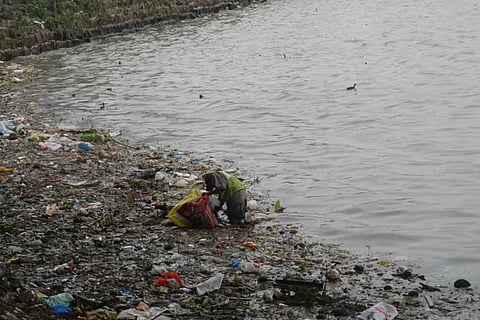

The Hyderabad High Court on Tuesday pulled up the state government, and noted that the city, which once had 7,000 lakes, did not even have 70 lakes remaining today.
"Even the busy Masab Tank area in the heart of the city was once a tank," the court exclaimed.
According to reports, 2016 saw more lakes being added to the 'vanished' list in Hyderabad, even as those that didn't vanish, dropped further down the scale in terms of pollution.
Even the city's proud heritage, the Hussain Sagar, which stands in the heart of the city, is nothing more than a mess of floating garbage today.
How bad is it?
"Like any other urban area in the country, we need to understand the problem, in the context of ever-expanding cities," says Purushottam Reddy, a noted environmentalist in the city.
"60 years ago, Hyderabad was a small city, which slowly began growing due to various factors. We ignored a large area around the city, which led to near famine conditions, and resulted in mass migration with people looking to eke out a livelihood," he adds.
Purushottam says that there was an absolute lack of planning as the city grew, and started expanding haphazardly, something which continues till today.
"What the urban administration does, is they put a map in place, and call it a 'master plan'. This plan is just a namesake, to show visiting dignitaries and the judiciary, and is never adhered to," he says.
As far as urban water bodies are concerned, Purushottam says that they are like 'orphans'.
"In rural areas, lakes come under the irrigation department, and there is concern for the water, due to active cultivation being connected with livelihood. On the other hand, semi-urban areas and cities do not reflect the same concern," he says.
"The lakes have practically vanished, as authorities show no interest in conserving them. The encroachments start from the backwaters and slowly start moving further inside. Since, the lake belongs to no one, no one protests and everyone remains a mute spectator," he adds.
Purushottam also criticises successive state governments for doling out public land to corporations, and looking the other way, when the latter violated environmental norms.
"Today, most of the lakes are shrinking and stinking due to utter neglect. That's about it," he adds.
A look at statistics and figures related to the lakes also show a similar result.
N Raveendhar, a senior scientist with the PCB, says, "There are around 34 important lakes in Telangana. Out of this,19 are in Hyderabad, and are strategically important, and must be conserved."
Raveendher says the main factor to determine the quality of water in a lake is its Biochemical Oxygen Demand (BOD), which is the amount of oxygen required for aquatic life.
While the BOD levels below 3mgpl can be considered clean, anything above 4 mgpl is considered polluted.
"However, what we see is that over the past few years, there has been a ten-fold increase, with many lakes going into double digits," says Raveendher.
The most polluted lake in the city, the Pragathinagar Cheruvu, is stated to have BOD levels as high as 144 mgpl, while the BOD for Mir Alam Lake is 38 mgl, and that of Noor Mohammed Kunta, is 105 mgl.
Reports also state that almost 92% of Hyderabad's lakes, tanks and ponds have been reduced to cesspools due to sewage.
Many lakes have also begun frothing, due to excessive chemical waste, in the city.
The Musi river, around which Hyderabad itself was established, is now just a giant sewer, carrying waste from several factories.
Why is this happening?
"We found that encroachments are the main problems in many of these places, as the catchment area of the lake has been built upon. There is also indiscriminate sewage that is entering the water bodies along with plastic waste," Raveendher says.
This has inevitably led to the lakes shrinking at an alarming rate, he adds.
While environmentalists say that minor encroachments on nalas and storm water drains by the lower rungs of society are contributing to the shrinking of the water bodies, it is nothing in comparison to the corporations.
“Even the richest of the rich are guilty of this,” says Purushottam.
One of the most public cases between the Telangana government and an encroacher occurred in July 2014.
The N-convention centre, a massive conference facility in Hyderabad's Hi-Tech city, was found to be built on lands encroaching the buffer zone and the Full Tank Level (FTL) of Tammidi Kunta, a lake.
The facility was owned by N3 Enterprises, a private company which belongs to Telugu Actor Akkineni Nagarjuna and his family.
The High Court ordered the GHMC to act in accordance with the law and demolish the illegal part of the construction.
But, a later investigation in 2015, found that nothing was demolished either by the GHMC or the management except for a shed.
"I along with some others, were one of the first people to have filed cases and petitions demanding that HUDA (then Hyderabad municipal body) even take the lakes into account in its master plan. The government had no interest in these water bodies, and things are not very different today," he says.
Raveendher says that political will is the only way.
"In independent India, when a government has a political will to act, anything is possible. Not one party has come out and announced in public that it is concerned about the environment," he says.
"Even the judiciary is to blame, as an occasional order will not help. The court has to ensure that there is a mechanism to ensure that all its previous orders are being compiled with," he adds.
Also read: